
Jan Harciník - 1st prize (ex aequo)
Student Competition of the Faculty of Architecture CTU: New Summer Stage in Český Krumlov
Atelier Cikán - Buš, Institute of Heritage Care FA CTU
The main principles of the theater design are:
...the continuation of the formal landscape of the baroque park into the landscape of informal nature and their interweaving, the extension of the baroque vista through the garden into the open countryside, the gradual opening of individual spaces of the new garden, the rhythmization of its axes in relation to the baroque rhythm of the park, long vistas and the events of the Stations of the Cross, leading to the path to Kvítkův dvůr, as a continuation of the romantic world in the baroque landscape behind the park wall...
All of this determines the location of the theater and its new stages in close connection with the castle garden, the continuation of the park, and its forms intertwined with the open landscape observed from the movable, rotating, and sliding audience stands gently floating on the water's surface.
Given that contemporary theater draws its success not only from its attractive rotating audience, but especially from the environment of the castle garden, it should, upon rediscovering a place outside of it, return to the original principles of scene changes based on the viewer's location in the landscape.
The lines of trimmed hornbeams, continuing from the garden into the informal landscape and following the line of the water surface, create several formal plans and perspectives, which, combined with the variability of the audience's position on the linear axis of the water element, multiply the possibilities for scene changes compared to the original placement. The hedges also completely conceal the technical background of the theater scenes. Thus, during the day, visitors do not have the impression that the place can transform into a maximally variable theatrical space offering more than 14 basic scenic options, which can be instantly changed by a quiet shift or rotation of the floating audience stands.
The design preserves the overall image of the natural landscape, into which a new line of water surface is "inscribed," which is a linear continuation of the rhythms and forms of the castle garden with the water surface featuring water lilies, enclosing the baroque world of the park. Existing trees in the surrounding groves are mostly preserved, only occasionally supplemented with new plantings.
Just as one pauses at the 14 existing Stations of the Cross and enjoys the romantic path to Kvítkův dvůr, the floating audience also pauses during the theatrical performance at various views into the scenes of the "new park" and open landscape.
There are existing free and new scenes available from traditional proscenium theaters, parks, paths, long vistas, to open landscapes – meadows, groves, small forests, reeds, and water lilies floating on the water line... Among the main scenes lying on the axes, actors can discover additional scenic possibilities multiplied by the quiet linear and rotating movement of the audience stands.
To preserve the undisturbed landscape, the main facilities of the theater have been hidden underground, and its wall covered with hornbeams. It offers a universal "hall," dressing rooms, makeup rooms, and storage spaces, which are ready to transform into a stage thanks to sliding walls. By opening the sliding walls, the café-foyer can be easily concealed or revealed, and similarly quietly screened during performances, which are merely evening guests in the landscape.
...the continuation of the formal landscape of the baroque park into the landscape of informal nature and their interweaving, the extension of the baroque vista through the garden into the open countryside, the gradual opening of individual spaces of the new garden, the rhythmization of its axes in relation to the baroque rhythm of the park, long vistas and the events of the Stations of the Cross, leading to the path to Kvítkův dvůr, as a continuation of the romantic world in the baroque landscape behind the park wall...
All of this determines the location of the theater and its new stages in close connection with the castle garden, the continuation of the park, and its forms intertwined with the open landscape observed from the movable, rotating, and sliding audience stands gently floating on the water's surface.
Given that contemporary theater draws its success not only from its attractive rotating audience, but especially from the environment of the castle garden, it should, upon rediscovering a place outside of it, return to the original principles of scene changes based on the viewer's location in the landscape.
The lines of trimmed hornbeams, continuing from the garden into the informal landscape and following the line of the water surface, create several formal plans and perspectives, which, combined with the variability of the audience's position on the linear axis of the water element, multiply the possibilities for scene changes compared to the original placement. The hedges also completely conceal the technical background of the theater scenes. Thus, during the day, visitors do not have the impression that the place can transform into a maximally variable theatrical space offering more than 14 basic scenic options, which can be instantly changed by a quiet shift or rotation of the floating audience stands.
The design preserves the overall image of the natural landscape, into which a new line of water surface is "inscribed," which is a linear continuation of the rhythms and forms of the castle garden with the water surface featuring water lilies, enclosing the baroque world of the park. Existing trees in the surrounding groves are mostly preserved, only occasionally supplemented with new plantings.
Just as one pauses at the 14 existing Stations of the Cross and enjoys the romantic path to Kvítkův dvůr, the floating audience also pauses during the theatrical performance at various views into the scenes of the "new park" and open landscape.
There are existing free and new scenes available from traditional proscenium theaters, parks, paths, long vistas, to open landscapes – meadows, groves, small forests, reeds, and water lilies floating on the water line... Among the main scenes lying on the axes, actors can discover additional scenic possibilities multiplied by the quiet linear and rotating movement of the audience stands.
To preserve the undisturbed landscape, the main facilities of the theater have been hidden underground, and its wall covered with hornbeams. It offers a universal "hall," dressing rooms, makeup rooms, and storage spaces, which are ready to transform into a stage thanks to sliding walls. By opening the sliding walls, the café-foyer can be easily concealed or revealed, and similarly quietly screened during performances, which are merely evening guests in the landscape.
The English translation is powered by AI tool. Switch to Czech to view the original text source.

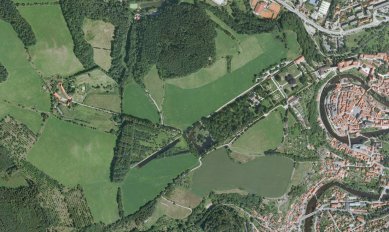

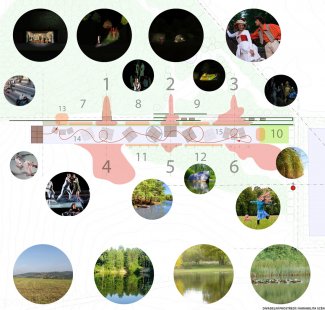
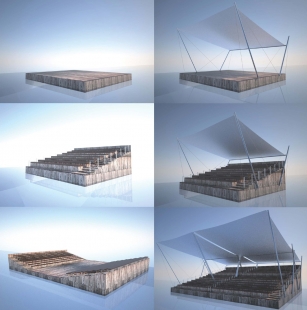
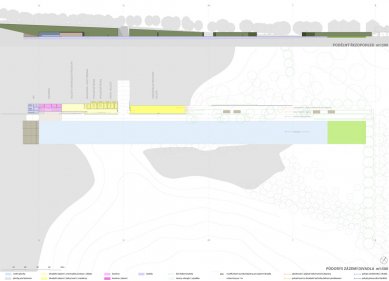
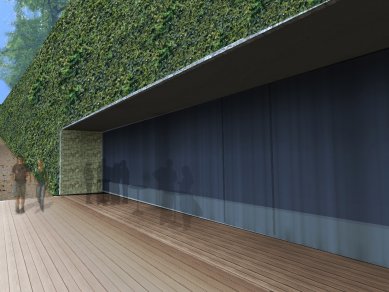
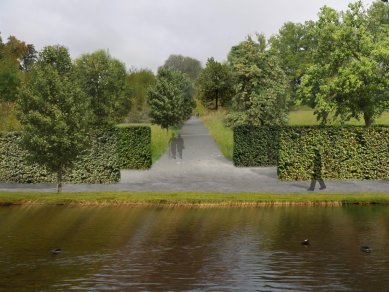
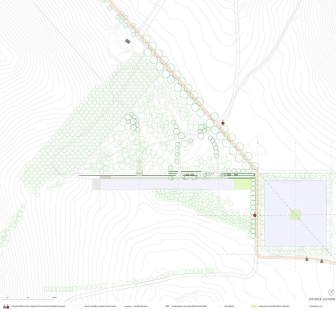
0 comments
add comment












